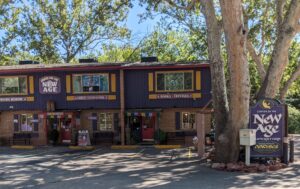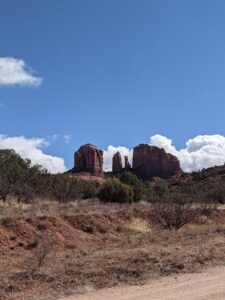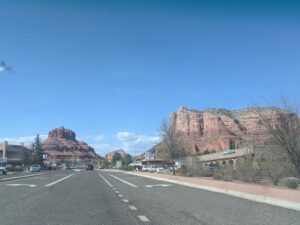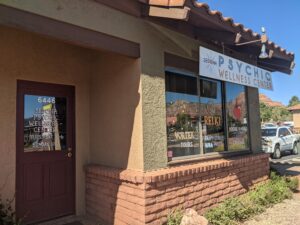SEDONA, ARIZONA TIMELINE
1300s: Indigenous Patayan groups separated and became the Yavapai people, who occupied the land around Oak Creek Canyon that was later called Sedona.
1861: White settlers began arriving, precipitating the Yavapai Wars between the US Army and the Yavapai and Tonto peoples.
1875 (February 27): Exodus Day, the forced march of the Yavapai people to the San Carlos reservation took place.
1876: The first white settler, John J. Thompson, moved to Oak Creek Canyon.
1902: City of Sedona founded, with fifty-five residents.
1912: Arizona became a state.
1956: Chapel of the Holy Cross was built.
1987 (August 16-17): The Harmonic Convergence took place.
1988: The City of Sedona incorporated.
2012 (December 21): The last date on the Mayan Calendar.
FOUNDER/GROUP HISTORY
The area now known as Sedona was inhabited for hundreds of years by the Wipukepa band of the Northeastern Yavapai prior to their forced removal in 1875. The Yavapai called it Wipuk, the Middle of the Earth where the first humans emerged (Harrison et al 2012). The first Spanish explorers to cross the high desert area saw it as a barren wasteland, just a natural obstacle blocking the way to Californian gold (Ivakhiv 2001:151). Ceded from Mexico in the early nineteenth century, there were few white settlers until the end of that century. Then the Southwest morphed into the “land of enchantment,” a resort and tourist attraction for the affluent coastal urban centres whose residents flock there for respite, first at sanitariums offering dry air to relieve consumption and then at hotels and golf courses offering year-round sun and expanses of empty space (Ivakhiv 2001:146; Sheridan 2006:5-6).
The Southwest’s rocky deserts and parched mesas have inspired fantastical legends of human and nonhuman others. Alien mythology is rooted in Southwestern sites; New Mexico is home to Roswell, Nevada to Area 51, Arizona to mysterious lights in the sky over Phoenix (Denzler 2001). Arizona is also rich in frontier mythology as the last battleground of “cowboys and Indians.” It still has the most Indigenous reservation land in the continental U.S.; the forced removals and marches of the prior occupants are a recent historical memory (Ivakhiv 2001:152). It stood as the cinematic backdrop for Westerns, living on as the frontier in the Hollywood imaginary (McNeill 2010: Ivakhiv 2001:156-57). Sedona was founded in the late nineteenth century after the forced removal of the Yavapai.
Sedona sits inside a network of red rock canyons and along the banks of Oak Creek, one of the few freshwater sources in Northern Arizona. The contrast of the bright sandstone against the open blue skies of Arizona and the verdant green trees growing creates a spectacular vista, particularly when approaching from the surrounding barren high desert landscapes. Sedona is a sacred site of new age spirituality. Its centrality is evidenced by its comparison in the literature to Mecca (Ivakhiv 2001:147).
The notion that Sedona is a maelstrom of invisible, yet potent spiritual energy is relatively recent and can be traced in historical accounts to the second half of the twentieth century. It became known for “vortexes,” red rock formations said to have spirals of special energy flowing through them. From the 1980s onward, it drew people involved in new age spirituality who claimed it was a sacred space. Local people claim that the vortexes were known to Native Americans, who held the whole area sacred (Ayres 1997:4-5). Ayres describes the emergence of new age activities in Sedona through the support of a realtor called Mary Lou Keller who had a building on Hillside in the 1960s where she let people hold spiritual activities for free. In Keller’s own account, the vortexes were known to the Native Americans and then Ruby Focus, a group now called Rainbow Ray Focus that is still present in Sedona, came with channelled information about the vortexes and bought property adjacent to the Airport Mesa vortex through Keller in 1963 (Keller 1991:xvi). She says this is the origin despite other claims.
The usual attribution in vortex guidebooks is to Dick Sutphen and Page Bryant, a pair of psychics who claimed to feel the vortexes in the 1980s (Andres 2002:14; Sutphen 1986:21). Sutphen has made a career out of psychic workshops held on Sedona’s vortexes aimed at developing psychic abilities, and publishing books about the vortexes and their powers. According to Ayres, Sutphen and Bryant only “publicized” the vortexes, along with Pete Saunders, another well-known Sedona psychic (1997:7). The claim that Native Americans knew about the vortexes is part of a strategy of legitimation (Hammer 2004:134-38). If the special energy is an inherent property of the earth, then it would have been known to the previous inhabitants, who are considered more spiritual by new agers.
Tourism has long since replaced Arizona’s three c’s: cattle, copper, and cotton (Sheridan 2012). Sedona is a shining jewel in this industry, drawing 3,000,000-4,000,000 visitors per year. New age spirituality is a significant part of this tourist draw. At first, the Sedona City Council and Chamber of Commerce disdained the influx of spiritual seekers, for example banning camping within the city limits so as to drive itinerant newcomers out of the town. Now the Chamber of Commerce gives out maps of the locations of vortexes. Sedona’s reputation as a metaphysical or spiritual destination is part of its appeal to  visitors, with the vortexes playing a part alongside spas, resorts, and hotels offering massage, meditation, and yoga in wellness vacations. The well-heeled Uptown shopping district is dotted with stores offering crystals, psychic readings, and healing modalities. [Image at right] Tour guides offer trips round the vortexes, UFO sighting tours, and hikes in nature. This is part of the well-attested overlap between new age spirituality and business (Heelas 2008).
visitors, with the vortexes playing a part alongside spas, resorts, and hotels offering massage, meditation, and yoga in wellness vacations. The well-heeled Uptown shopping district is dotted with stores offering crystals, psychic readings, and healing modalities. [Image at right] Tour guides offer trips round the vortexes, UFO sighting tours, and hikes in nature. This is part of the well-attested overlap between new age spirituality and business (Heelas 2008).
DOCTRINES/BELIEFS
New age spirituality is a secularised and democratised esotericism for late modernity (Hanegraaff 1996:517). Sedona is a site that draws spiritual seekers of various levels of commitment, a location of both pilgrimage and migration. It is said to have special energy, which is the central organising concept of new age spirituality. Energy is everything, in that everything vibrates at specific frequencies (Albanese 2006:495-99: Kripal 2007:19; Prince and Riches 2000:91-92; Ivakhiv 2001:24-30; Bender 2010:115; Hanegraaff 1996:175). Sedona has a particularly high vibration; it is sacred within the cosmology of new age spirituality. Its high vibration is created by its position at an intersection of ley-lines, energetic lines of high vibrational frequencies that crisscross the earth (Ivakhiv 2001:24-30, 185-92). These intersection points are marked by vortexes, also sometimes called the earth’s chakras or circulatory system. This links Sedona to other sacred sites in new age spirituality such as Mount Shasta, California, and Maui, Hawaii, through the invisible yet potent force of energy.

The whole area where Sedona is located is said to be a vortex; there are also specific vortex sites. The four main ones in Sedona are Cathedral Rock, [Image at right] Bell Rock, Airport Mesa, and Boynton Canyon. These rock formations are among some of the most photographed sites in Arizona (Ivakhiv 1997:377). Spiritual seekers report feeling different at vortex sites; energy is felt or intuited rather than seen or heard. The energy at vortex sites is amplified and this means that seekers go there to have spiritual experiences. Practices such as meditation, psychic readings, and channelling are common. The sacredness of Sedona is felt by those who do not fully subscribe to the new age concept of energy but who nonetheless feel that its aesthetically pleasing and sublime landscape imbues it with the presence of the divine. This is a broader phenomenon of nature religion that overlaps with contemporary esotericism particularly in the U.S. (Albanese 1990, 2002). The landscape of Sedona combined with its proximity to the Grand Canyon and San Francisco Peaks creates a stunning visual aspect of “big nature” that contributes significantly to the spiritual elaboration of Sedona. The vortexes draw the spiritual seekers, but the landscape has a much broader appeal.
RITUALS/PRACTICES
On August 16-17, 1987, the Harmonic Convergence was announced by new age author and artist José Argüelles (Ivakhiv 2001: 48). It was a simultaneous and synchronised act of prayer in different “power spots,” such as Sedona and Glastonbury, around the world. Argüelles claimed it would launch the final twenty-six year period of the Great Cycle of the Mayan calendar, and if enough people prayed, chanted, and channelled at the same time it would launch the twenty-five year transition to the New Age of peace and harmony. People gathered in Sedona expecting, among other things, a spaceship to come out of Bell Rock. A number of the spiritual seekers who came to Sedona at that time stayed on and became the nucleus of the growing spiritual community in the town.

December 21, 2012 was meant to mark the end of the transition cycle to the New Age, and the end of the Mayan calendar’s Great Cycle. Fewer people gathered in Sedona than in 1987. However one Sedona resident, Peter Gersten, gained local and national renown for his prediction that a portal would open on December 21 at Bell Rock, [Image at right] one of the vortexes (Crockford 2021:64-93). He claimed he would step through the portal to save the world from the virus of technology. He went to the top of Bell Rock with a small group of people on December 21 and waited for fourteen hours for a portal to open. When it did not, he climbed back down without jumping as many locally and in the media rumored he would.
Many smaller events are held in Sedona inspired by the understanding that it is a sacred place with special energy. The date 11/11/11 was considered numerologically significant and was marked by rituals and ceremonies in Sedona, such as a performance held at the Sedona Creative Life Center of dancing, chanting, and drumming. Monthly drum circles are held at the Cathedral Rock vortex, where local people and tourists gather to dance and drum during the full moon.
ORGANIZATION/LEADERSHIP
Sedona draws individual figures involved in spirituality, such as Drunvalo Melchizedek, an author and populariser of the concept of sacred geometry who lives in Sedona and held retreats there. Many individuals move to Sedona to follow their spiritual path, opening the small businesses which populate the spirituality-oriented sector of the economy (Ivakhiv 2001:175). Groups have set up centres in Sedona, such as Dahn Yoga, a Korean new age group with international range. There are also thirty Christian Churches, a Jewish Synagogue, and several spiritual centres such as a branch of the New Thought influenced Unity Church and the Church of the Golden Age.
Sedona is an enclave of new age spirituality, in that it draws spiritual seekers who explicitly describe themselves as drawn there by its special energy or “vortexes.” It is well-known within spirituality as a “power spot” or sacred site. However, although Sedona is a sacred site for new spirituality, it does not have the status of an established and institutional centre for a religion, like Mecca does in Islam. The spiritual community does not hold political power in Sedona and is often ignored or disdained by those who do hold power locally, such as the City Council and Chamber of Commerce. These institutions are dominated by property owners in Sedona and tend to be older members of the community who have been there for many decades or have significant assets in the area.
There are some small, private educational institutions in the town that train visitors in spiritual practices such as yoga, massage therapy, and esoteric philosophical ideas. For example, the University of Sedona is an unaccredited distance learning college providing instruction in what it calls “metaphysical” studies. It is based in a strip mall in West Sedona. New age spirituality is more conspicuously incorporated into the town’s  economy through the tourist industry. There are numerous businesses that cater to visitors seeking to engage more with new age spirituality. The most apparent form of these businesses are the stores in the Uptown area that sell spiritual items and services, [Image at right] such as crystals, sage bundles, oracle cards, psychic readings, aura photography, and vortex tours. There are also independent spiritual businesspeople, who sometimes call themselves conscious entrepreneurs, that sell services such as holistic pedicures, yoga instruction, or massage therapy. Some have grouped together in the Sedona Metaphysical and Spiritual Association (SMSA), which members pay a fee to join and in return advertise their services collectively through a website that lists categories of services such as retreats, tours, readings, ceremonies, teaching, and healing. Membership of the SMSA is intended to give established spiritual practitioners in the town some level of respectability. One of the recurrent criticisms from other residents is that people involved in new age spirituality are simply “grifters” selling “fake” services to take advantage of gullible tourists.
economy through the tourist industry. There are numerous businesses that cater to visitors seeking to engage more with new age spirituality. The most apparent form of these businesses are the stores in the Uptown area that sell spiritual items and services, [Image at right] such as crystals, sage bundles, oracle cards, psychic readings, aura photography, and vortex tours. There are also independent spiritual businesspeople, who sometimes call themselves conscious entrepreneurs, that sell services such as holistic pedicures, yoga instruction, or massage therapy. Some have grouped together in the Sedona Metaphysical and Spiritual Association (SMSA), which members pay a fee to join and in return advertise their services collectively through a website that lists categories of services such as retreats, tours, readings, ceremonies, teaching, and healing. Membership of the SMSA is intended to give established spiritual practitioners in the town some level of respectability. One of the recurrent criticisms from other residents is that people involved in new age spirituality are simply “grifters” selling “fake” services to take advantage of gullible tourists.
ISSUES/CHALLENGES
The spiritual activities held in Sedona have on occasion attracted controversy. A member of a hike organised by Dahn Yoga died of exhaustion in 2003. A group led by Gabriel of Sedona lived in an intentional community, called Global Community Communications Alliance, that was the subject of a Dateline exposé and a series of inflammatory editorials in the local paper, the Sedona Red Rock News, for being a “cult.” They left Sedona for Tubac because of the exposure. In 2009, James Arthur Ray led a weekend Spiritual Warrior workshop which included a sweat lodge, held at Angel Valley Retreat Center just outside of Sedona, in which three people died. It was widely reported in the national and international press and Ray received two years’ imprisonment for negligent homicide. A spiritual leader named Bentinho Massaro moved to Sedona in the mid-2010s until an attendee at one of his retreats committed suicide in 2018.
These well-publicised cases are often over-emphasised in the media. In Sedona, many people move there because they feel it has special energy, start a business or work in the local tourism economy, and pursue esoteric practices on an individual basis. A visit to Sedona is often the start of their spiritual path. They come, have an experience in the vortexes that they describe as spiritual, change their life and job to move to Sedona, and pursue their spirituality. It is often hard to stay because of the price of rent and the dearth of employment, turnover is high. However, new age spirituality remains a significant factor in the economy and social life of Sedona.
IMAGES
Image #1: New Age Center in Sedona. Photograph copyright, Susannah Crockford.
Image #2: Cathedral Rock vortex site. Photograph copyright, Susannah Crockford.
Image #3: Bell Rock and Courthouse Rock vortex sites, from the perspective of the Village of Oak Creek. Photograph copyright, Susannah Crockford.
Image #4: Sedona Psychic Wellness Center. Photograph copyright, Susannah Crockford.
REFERENCES
Albanese, Catherine L. 2007. A Republic of Mind and Spirit: A Cultural History of American Metaphysical Religion. Yale University Press.
Albanese, Catherine L. 2002. Reconsidering Nature Religion. Harrisburg, PA: Trinity.
Albanese, Catherine L. 1990. Nature Religion in America: From the Algonkian Indians to the New Age. Chicago: University of Chicago Press.
Andres, D. 2007. Sedona: The Essential Guide. Sedona: Meta Adventures Publishing.
Andres, D. 2002. What Is a Vortex? Sedona: Meta Adventures Publishing.
Ayres, Toraya. 1997. The History of New Age Sedona. Cedar City, Utah: High Mountain Training and Publishing.
Bender, Courtney. 2010. The New Metaphysicals: Spirituality and the American Religious Imagination. Chicago: Chicago University Press.
Bowman, Marion. 1999. “Healing in the Spiritual Marketplace: Consumers, Courses and Credentialism.” Social Compass 46:181–89.
Bradshaw, Bob. 1994. Sedona: Red Rock Country. Sedona: Bradshaw Color Studios.
Brown, Michael F. 1999. The Channelling Zone: American Spirituality in an Anxious Age. Cambridge, MA: Harvard University Press.
Crockford, Susannah. 2021. Ripples of the Universe: Spirituality in Sedona, Arizona. Chicago: University of Chicago Press.
Dannelley, Richard. 1992. Sedona Power Spot, Vortex & Medicine Wheel Guide. Sedona: Vortex Society.
Dean, Jodi. 1998. Aliens in America: Conspiracy Cultures from Outerspace to Cyberspace. Ithaca, NY: Cornell University Press.
Denzler, Brenda. 2003. The Lure of the Edge : Scientific Passions, Religious Beliefs, and the Pursuit of UFOs. Berkeley: University of California Press.
Dongo, Tom. 1988. The Mysteries of Sedona: The New Age Frontier. Sedona: Hummingbird.
Hammer, Olav. 2004. Claiming Knowledge: Strategies of Epistemology from Theosophy to the New Age. Sciences-New York. Leiden: Brill.
Hanegraaff, Wouter J. 2000. “New Age Religion and Secularization.” Numen 47:288–312.
Hanegraaff, Wouter J. 1996. New Age Religion and Western Culture: Esotericism in the Mirror of Secular Thought. Leiden: Brill.
Harrison, Mike, John Williams, Sigrid Khera, and Carolina C. (Carolina Castillo) Butler. 2012. Oral History of the Yavapai. Acacia Publishing.
Heelas, Paul. 2008. Spiritualities of Life : New Age Romanticism and Consumptive Capitalism. Hoboken, NJ: Wiley-Blackwell.
Ivakhiv, Adrian. 2007. “Power Trips: Making Sacred Space through New Age Pilgrimage.” Pp. 263-90 in Handbook of the New Age, edited by Daren Kemp and James R. Lewis. Leiden: Brill.
Ivakhiv, Adrian. 2003. “Nature and Self in New Age Pilgrimage.” Culture and Religion 4:93–118.
Ivakhiv, Adrian. 2001. Claiming Sacred Ground: Pilgrims and Politics at Glastonbury and Sedona. Bloomington: Indiana University Press.
Ivakhiv, Adrian. 1997. “Red Rocks, ‘Vortexes’ and the Selling of Sedona: Environmental Politics in the New Age.” Social Compass 44:367–84.
Johansen, Gayle and Shinan Naom Barclay. 1987. The Sedona Vortex Experience. Sedona: Sunlight Productions.
Johnson, Hoyt. 1998. Sedona: The Most Uniquely Beautiful Site on Earth. Sedona: Sedona Publishing.
Keller, Mary Lou. 1991. “Introduction: Echoes of the Past.” Pp. vi-xvi in Sedona Vortex Guide Book, edited by Page Bryant. Sedona: Light Technology Publishing.
Kemp, Daren, and James R. Lewis, eds. 2007. Handbook of the New Age. Leiden: Brill.
Kripal, Jeffrey J. 2007. Esalen: America and the Religion of No Religion. University of Chicago Press.
McNeill, Joe. 2010. Arizona’s Little Hollywood: Sedona and Northern Arizona’s Forgotten Film History 1923-1973. Sedona: Northedge & Sons.
Partridge, Christopher. 2004. Re-Enchantment of the West: Alternative Spiritualities, Sacralisation, Popular Culture and Occulture. London: T&T Clark.
Pearson, Joanne, Richard H. Roberts, and Geoffrey Samuel, eds. 1998. Nature Religion Today: Paganism in the Modern World. Edinburgh: Edinburgh University Press.
Pike, Sarah. 2004. New Age and Neopagan Religions in America. New York: Columbia University Press.
Possamai, Adam. 2003. “Alternative Spiritualities and the Cultural Logic of Late Capitalism.” Culture and Religion 4:31–43.
Prince, Ruth, and David Riches. 2000. The New Age in Glastonbury: The Construction of Religious Movements. New York: Berghahn Books.
Schnebly Heidinger, L. J. Trevillyan, and The Sedona Historical Society. 2007. Sedona. Charleston: Arcadia Publishing.
Shapiro, Robert, Janet McClure and Lyssa Holt. 1991. Sedona Vortex Guide Book. Flagstaff, AZ: Sedona: Light Technology Publishing.
Sheridan, Thomas E. 2012. Arizona a History. University of Arizona Press.
Sutcliffe, Steven. 2003. Children of the New Age: A History of Spiritual Practices. London: Routledge.
Sutphen, Dick. 1986. Dick Sutphen Presents Sedona: Psychic Energy Vortexes. Malibu, CA: Valley of the Sun Publishing.
Publication Date:
21 February 2022
